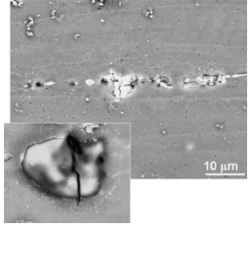The Problem We plan to preform cracked/un-cracked simulations on particle clusters with multiple shear and uniaxial loadings. Following, we seek to process cluster statistics in order to relate to growth and static stress fields such that it is possible to predict the onset of cracking based on experimental data.
Simple Background Aluminum Alloy 7075 (AA 7075) is an aluminum alloy whose composition is composed largely of 5.1-6.1% zinc, 2.1-2.9% magnesium, 1.2-2.0% copper and <0.5% Iron, Silicon, Manganese, Chromium, Zirconium and Titanium [1]. During the material processing and hot rolling stages of the alloy, it is common for μm-sized particles to become ingrained in the material matrix. Rollett Et al. have stated that these particles contribute up to 2% of the total volume of the matrix [2]. Deformation of the alloy can cause these particles to either crack or become fully detached from the matrix. When the alloy is eventually put under stress, these cracked particles and the areas where the particles have detached can cause the matrix itself to crack. A crack in the matrix combined with continued stress can cause a failure within the section of the alloy.
 [3]
[3]
Importance AA 7075 is a material commonly used in the construction of airframes. As such, the failure of the AA 7075 sections of the frames can be a costly danger. Better modeling of cracked and un-cracked particles in AA 7075 can increase the knowledge base and aid in the prediction of the particles/structures that have larger probabilities of cracking. Furthermore, improved modeling can help to understand the conditions under which these particles and structures crack, causing overall AA 7075 failure. The benefits of closing the knowledge gap include improved quality control and decreasing costs.
A related post contains our planned course of action on the previously described problem..
[1] MakeItFrom, 2015, “7075 Aluminum”, from http://www.makeitfrom.com/material-properties/7075-AlZn5.5MgCu-3.4365-2L95-A97075-Aluminum/ [2] Rollett Et al, 2006, “Three Dimensional Microstructures: Statistical Analysis of Second Phase Particles in AA7075-T651”, Materials Science Forum, Vols. 519-521, pp 1-10. [3] Xue, Et al, 2007, “Micromechanisms of multistage fatigue crack growth in a high-strength aluminum alloy”, Acta Materialia, Vol. 55, pp 1975-1984.